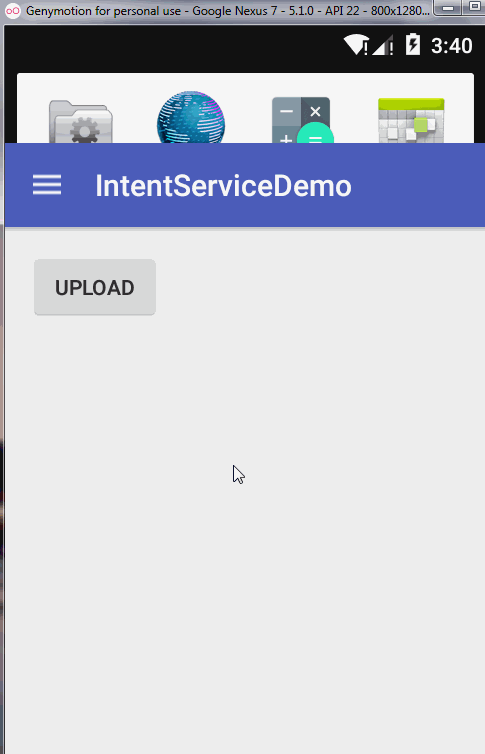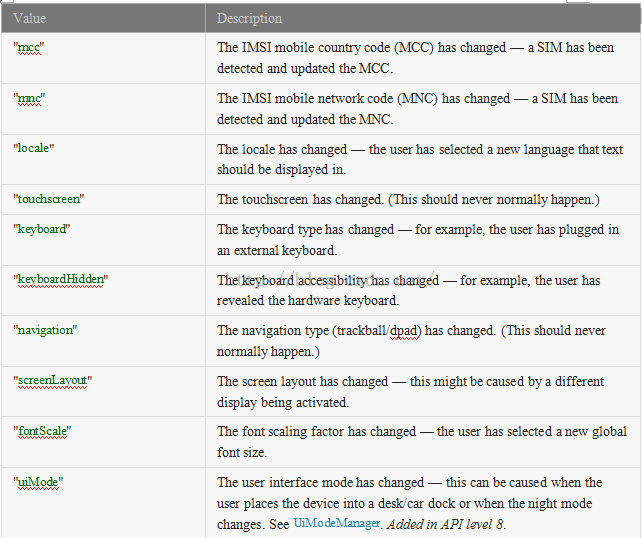編輯:關於android開發

在即時聊天中可能會存在一個隱藏的Bug,這個Bug根據手機的網速和性能有關系,比如你即時聊天中,你發送一消息,你的網絡情況不是很好,這個時候你發送的消息一直處於發送狀態,然後你不想看了,就按退出,這個時候Activity或者Fragment被銷毀的時候就導致了這個消息被強行GC了,所以為了解決這個方案,我們可以使用IntentService,什麼是IntentService?
/*IntentService is a base class for {@link Service}s that handle asynchronous
requests (expressed as {@link Intent}s) on demand. Clients send requests
through {@link android.content.Context#startService(Intent)} calls; the
service is started as needed, handles each Intent in turn using a worker
thread, and stops itself when it runs out of work.*/從這個解釋中可以看出來是一個異步服務,而且不用擔心他自己的生命周期.所以我們就可以使用它去發送消息,當然消息發送完畢後,我們肯定要通知界面更新UI,這個時候我們就需要使用廣播比較方便些.我們可以這樣寫一個IntentService:
package com.softtanck.intentservicedemo.service;
import android.app.IntentService;
import android.content.Context;
import android.content.Intent;
import com.softtanck.intentservicedemo.MainActivity;
/**
* Created by winterfell on 11/17/2015.
*/
public class UpLoadImgService extends IntentService {
public UpLoadImgService() {
super("ceshi");
}
/**
* Creates an IntentService. Invoked by your subclass's constructor.
*
* @param name Used to name the worker thread, important only for debugging.
*/
public UpLoadImgService(String name) {
super(name);
}
public static void startUploadImg(Context context, String path) {
Intent intent = new Intent(context, UpLoadImgService.class);
intent.setAction(MainActivity.UPLOAD_IMG);
intent.putExtra(MainActivity.EXTRA_IMG_PATH, path);
context.startService(intent);
}
@Override
protected void onHandleIntent(Intent intent) {
if (null != intent) {
String action = intent.getAction();
if (action.equals(MainActivity.UPLOAD_IMG)) {
//UpLoad file
uploadImg(intent.getStringExtra(MainActivity.EXTRA_IMG_PATH));
}
}
}
private void uploadImg(String path) {
try {
Thread.sleep(2000);
Intent intent = new Intent(MainActivity.UPLOAD_IMG);
intent.putExtra(MainActivity.EXTRA_IMG_PATH, path);
sendBroadcast(intent);
} catch (InterruptedException e) {
e.printStackTrace();
}
}
}
然後在需要的地方去調用:
UpLoadImgService.startUploadImg(MainActivity.this, "/sdcard/cache/com.softtanck.intentservice/1.png");
還有就是IntentService是繼承的Service,那麼它是怎麼實現異步線程的.?我們先粗略看一下它的源碼:
/*
* Copyright (C) 2008 The Android Open Source Project
*
* Licensed under the Apache License, Version 2.0 (the "License");
* you may not use this file except in compliance with the License.
* You may obtain a copy of the License at
*
* http://www.apache.org/licenses/LICENSE-2.0
*
* Unless required by applicable law or agreed to in writing, software
* distributed under the License is distributed on an "AS IS" BASIS,
* WITHOUT WARRANTIES OR CONDITIONS OF ANY KIND, either express or implied.
* See the License for the specific language governing permissions and
* limitations under the License.
*/
package android.app;
import android.annotation.WorkerThread;
import android.content.Intent;
import android.os.Handler;
import android.os.HandlerThread;
import android.os.IBinder;
import android.os.Looper;
import android.os.Message;
/**
* IntentService is a base class for {@link Service}s that handle asynchronous
* requests (expressed as {@link Intent}s) on demand. Clients send requests
* through {@link android.content.Context#startService(Intent)} calls; the
* service is started as needed, handles each Intent in turn using a worker
* thread, and stops itself when it runs out of work.
*
* This "work queue processor" pattern is commonly used to offload tasks
* from an application's main thread. The IntentService class exists to
* simplify this pattern and take care of the mechanics. To use it, extend
* IntentService and implement {@link #onHandleIntent(Intent)}. IntentService
* will receive the Intents, launch a worker thread, and stop the service as
* appropriate.
*
*
All requests are handled on a single worker thread -- they may take as
* long as necessary (and will not block the application's main loop), but
* only one request will be processed at a time.
*
*
*
Developer Guides
* For a detailed discussion about how to create services, read the
* Services developer guide.
*
*
* @see android.os.AsyncTask
*/
public abstract class IntentService extends Service {
private volatile Looper mServiceLooper;
private volatile ServiceHandler mServiceHandler;
private String mName;
private boolean mRedelivery;
private final class ServiceHandler extends Handler {
public ServiceHandler(Looper looper) {
super(looper);
}
@Override
public void handleMessage(Message msg) {
onHandleIntent((Intent)msg.obj);
stopSelf(msg.arg1);
}
}
/**
* Creates an IntentService. Invoked by your subclass's constructor.
*
* @param name Used to name the worker thread, important only for debugging.
*/
public IntentService(String name) {
super();
mName = name;
}
/**
* Sets intent redelivery preferences. Usually called from the constructor
* with your preferred semantics.
*
* If enabled is true,
* {@link #onStartCommand(Intent, int, int)} will return
* {@link Service#START_REDELIVER_INTENT}, so if this process dies before
* {@link #onHandleIntent(Intent)} returns, the process will be restarted
* and the intent redelivered. If multiple Intents have been sent, only
* the most recent one is guaranteed to be redelivered.
*
*
If enabled is false (the default),
* {@link #onStartCommand(Intent, int, int)} will return
* {@link Service#START_NOT_STICKY}, and if the process dies, the Intent
* dies along with it.
*/
public void setIntentRedelivery(boolean enabled) {
mRedelivery = enabled;
}
@Override
public void onCreate() {
// TODO: It would be nice to have an option to hold a partial wakelock
// during processing, and to have a static startService(Context, Intent)
// method that would launch the service & hand off a wakelock.
super.onCreate();
HandlerThread thread = new HandlerThread("IntentService[" + mName + "]");//創建了一個HandlerThread
thread.start();
mServiceLooper = thread.getLooper();
mServiceHandler = new ServiceHandler(mServiceLooper);
}
@Override
public void onStart(Intent intent, int startId) {
Message msg = mServiceHandler.obtainMessage();
msg.arg1 = startId;
msg.obj = intent;
mServiceHandler.sendMessage(msg);
}
/**
* You should not override this method for your IntentService. Instead,
* override {@link #onHandleIntent}, which the system calls when the IntentService
* receives a start request.
* @see android.app.Service#onStartCommand
*/
@Override
public int onStartCommand(Intent intent, int flags, int startId) {
onStart(intent, startId);
return mRedelivery ? START_REDELIVER_INTENT : START_NOT_STICKY;
}
@Override
public void onDestroy() {
mServiceLooper.quit();
}
/**
* Unless you provide binding for your service, you don't need to implement this
* method, because the default implementation returns null.
* @see android.app.Service#onBind
*/
@Override
public IBinder onBind(Intent intent) {
return null;
}
/**
* This method is invoked on the worker thread with a request to process.
* Only one Intent is processed at a time, but the processing happens on a
* worker thread that runs independently from other application logic.
* So, if this code takes a long time, it will hold up other requests to
* the same IntentService, but it will not hold up anything else.
* When all requests have been handled, the IntentService stops itself,
* so you should not call {@link #stopSelf}.
*
* @param intent The value passed to {@link
* android.content.Context#startService(Intent)}.
*/
@WorkerThread
protected abstract void onHandleIntent(Intent intent);
}
從源碼中可以看出在OnCreat的時候初始化了一個HandlerThread,然後通過Looper的Loop去從消息隊列裡面去,建立了Handler的通信,而HandlerMessage中調用一個抽象的方法就是我們繼承IntentService中的要實現的方法,該方法就是在線程中的,所以不需要再去開啟線程.它的生命周期也是由Service是管理的.
 Android 配置文件(activity)元素
Android 配置文件(activity)元素
Android 配置文件(activity)元素 語法: . . . 被包含在: 可以包含: 描述: 聲明實現了應用程序可視化
 Android開發之初識MVP模式
Android開發之初識MVP模式
Android開發之初識MVP模式 各位親愛的小伙伴,有沒有想我啊,我胡漢wing又回來了。 很長一段時間沒有更新博客。。原因是。。從離職回到學校以後,一直在享受最
 總結一下Android中主題(Theme)的正確玩法,androidtheme
總結一下Android中主題(Theme)的正確玩法,androidtheme
總結一下Android中主題(Theme)的正確玩法,androidtheme在AndroidManifest.xml文件中有<application androi
 RecyclerView,androidrecyclerview
RecyclerView,androidrecyclerview
RecyclerView,androidrecyclerview1.簡介 RecyclerView是一種新的視圖組,目標是為任何基於適配器的視圖提供相似的渲染方式。它